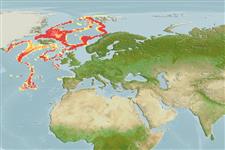Teleostei (teleosts) >
Perciformes/Zoarcoidei (Eelpouts and pricklebacks) >
Zoarcidae (Eelpouts) > Lycodinae
Etymology: Lycodonus: Derived from Greek, Lykos = wolf + Greek, onos = hake.
Environment: milieu / climate zone / depth range / distribution range
Ecology
Marine; bathydemersal; depth range 800 - 1993 m (Ref. 11954). Deep-water
Northeast Atlantic: Greenland and Norwegian seas, from north of Iceland to Jan Mayen Island and south to Faroe Channel, also from south-west of Spitsbergen.
Size / Weight / Age
Maturity: Lm ? range ? - ? cm
Max length : 19.9 cm SL male/unsexed; (Ref. 11954)
Inhabits muddy bottoms with temperatures below 0°C. Feeds on small crustaceans like Themisto, Podocerus and Hemilamprops (Ref. 4695).
Life cycle and mating behavior
Maturity | Reproduction | Spawning | Eggs | Fecundity | Larvae
Andriashev, A.P., 1986. Zoarcidae. p. 1130-1150. In P.J.P. Whitehead, M.-L. Bauchot, J.-C. Hureau, J. Nielsen and E. Tortonese (eds.) Fishes of the North-eastern Atlantic and the Mediterranean. volume 3. UNESCO, Paris. (Ref. 4695)
IUCN Red List Status (Ref. 130435: Version 2024-2)
Threat to humans
Harmless
Human uses
Tools
Special reports
Download XML
Internet sources
Estimates based on models
Preferred temperature (Ref.
123201): -0.9 - 5.3, mean -0.6 °C (based on 200 cells).
Phylogenetic diversity index (Ref.
82804): PD
50 = 0.5625 [Uniqueness, from 0.5 = low to 2.0 = high].
Bayesian length-weight: a=0.00120 (0.00058 - 0.00248), b=3.10 (2.91 - 3.29), in cm total length, based on LWR estimates for this (Sub)family-body shape (Ref.
93245).
Trophic level (Ref.
69278): 3.5 ±0.50 se; based on food items.
Resilience (Ref.
120179): Medium, minimum population doubling time 1.4 - 4.4 years (Preliminary K or Fecundity.).
Fishing Vulnerability (Ref.
59153): Low vulnerability (14 of 100).
